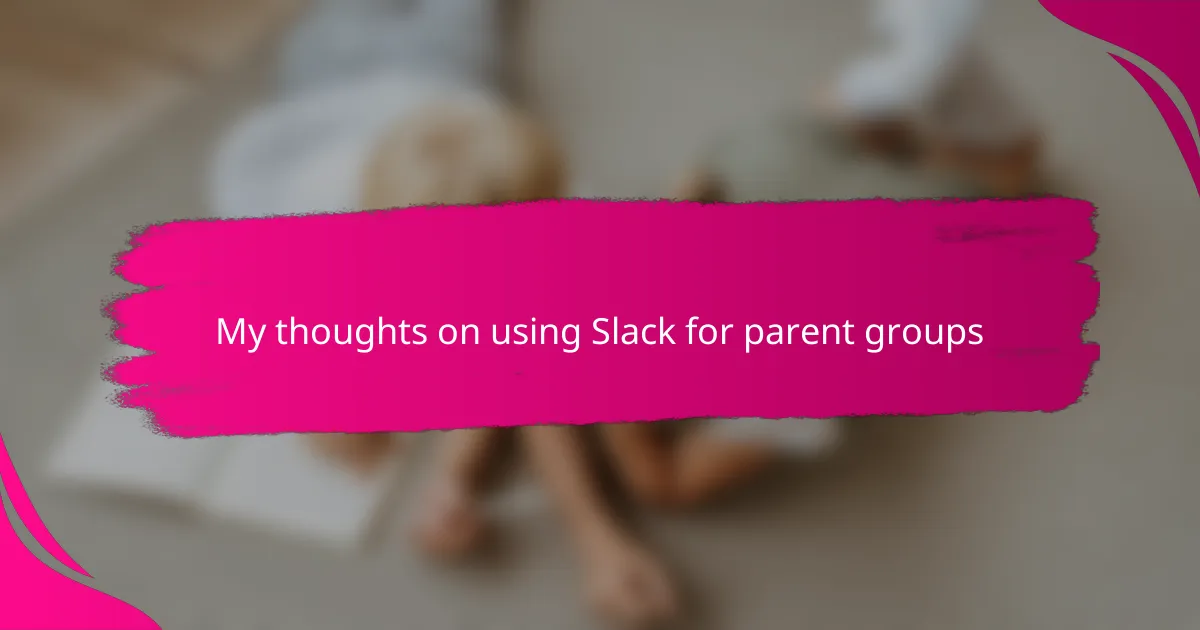Key takeaways
- Slack improves communication in parent groups by organizing discussions into focused channels, reducing chaos and enhancing clarity.
- Real-time interaction fosters instant support, making it easier for parents to seek advice during emergencies.
- Setting clear guidelines and using threads helps manage conversations and maintain a respectful environment.
- Engaging members through open-ended questions and personal invitations can boost participation and foster community connections.
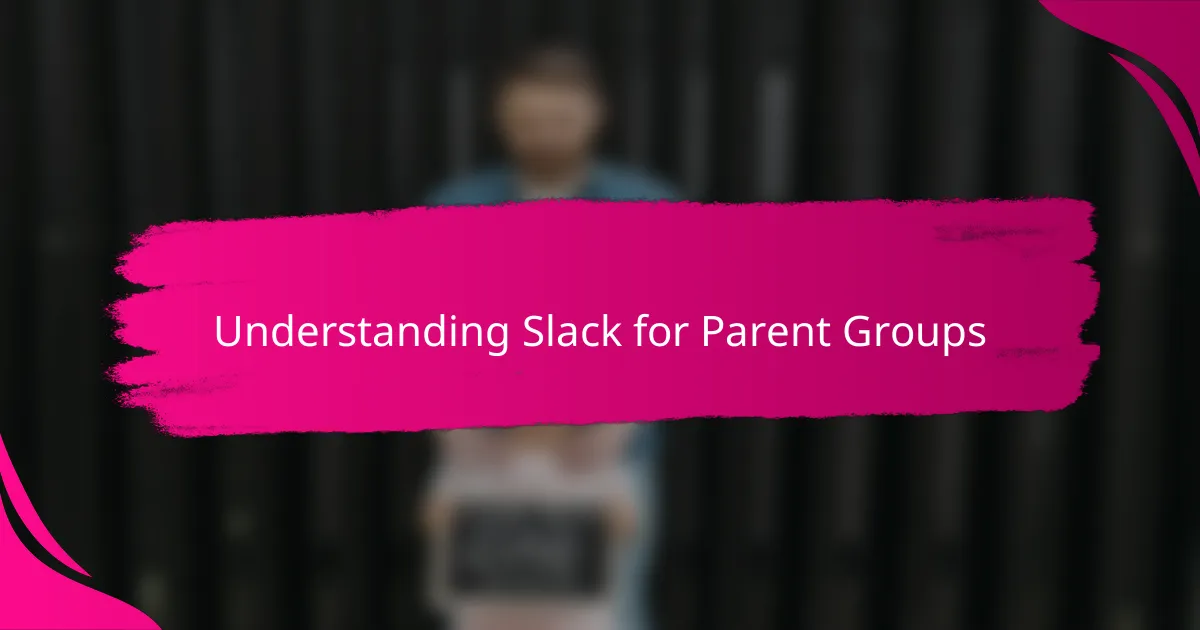
Understanding Slack for Parent Groups
Slack is fundamentally a communication tool designed to bring people together through organized conversations. When I first joined a parent group on Slack, I was surprised by how smoothly discussions flowed, compared to endless email chains or chaotic social media threads. It made me wonder—could this be the key to avoiding those frustrating, scattered chats we all experience in parenting communities?
What struck me most was the use of channels—dedicated spaces for specific topics—that kept conversations tidy and focused. Instead of one big, noisy room, I could quickly catch up on school events in one channel and swap parenting hacks in another. This structure made me realize how much easier it is to stay connected without feeling overwhelmed.
At its core, Slack is about flexibility and real-time interaction, which feels crucial when parenting challenges pop up unexpectedly. Have you ever needed a quick answer or advice at odd hours? Slack’s design lets parent groups support each other instantly, creating a sense of community that feels both personal and practical.
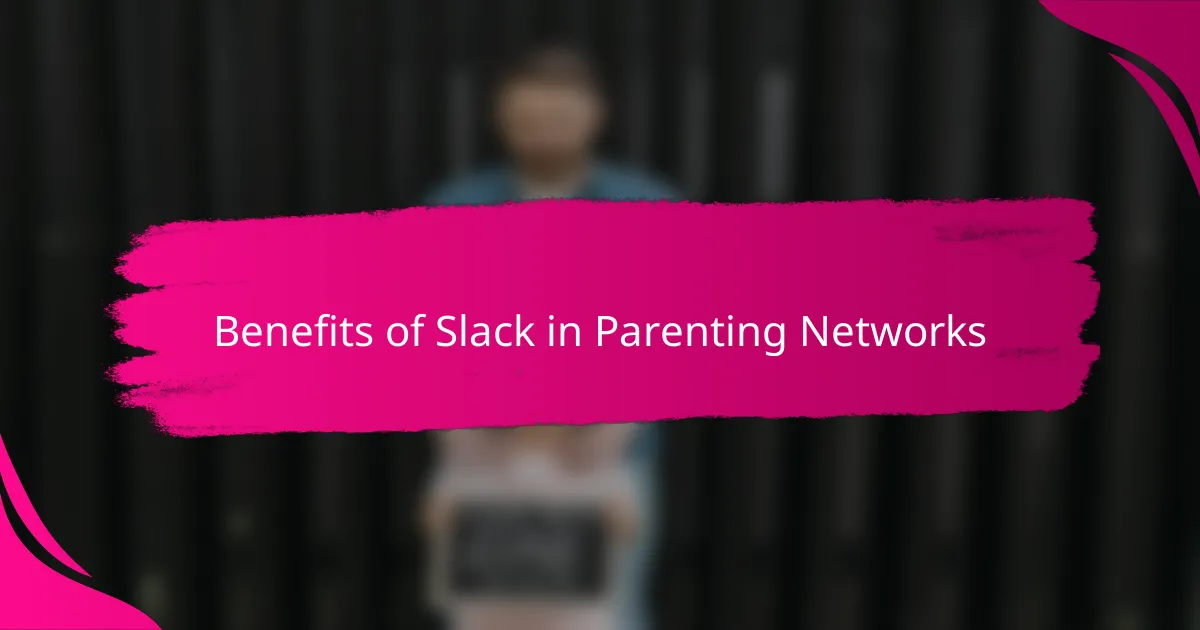
Benefits of Slack in Parenting Networks
One of the biggest benefits I noticed with Slack in parent groups is how it organizes conversations into channels. Instead of chasing replies scattered across emails or endless social media comments, everything has its own space. Doesn’t it feel good knowing you can quickly find advice on bedtime routines separate from discussions about school trips?
Another thing I appreciate is the immediacy Slack offers. Parenting can throw curveballs at any time, so being able to ask a question and get real-time responses is a game-changer. I remember one night when my toddler was suddenly sick—I posted in the group, and within minutes, other parents shared tips and reassured me. That kind of instant support really makes you feel less alone.
Finally, Slack’s ability to share files, links, and photos right where conversations happen adds so much value. It’s like having a little toolkit for parenting right at your fingertips. Have you ever struggled to find that one recipe or link someone mentioned briefly in a chat? With Slack, I no longer have to dig through memories because everything is saved and searchable.
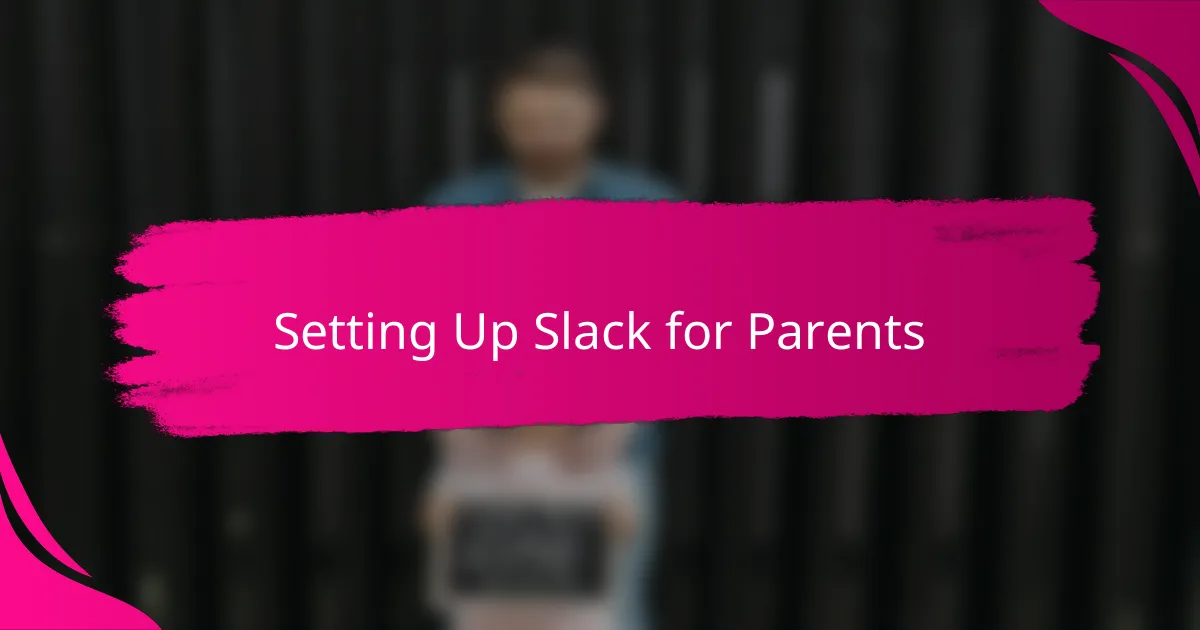
Setting Up Slack for Parents
Getting started with Slack for parent groups is simpler than I expected. When setting up, I made sure to create channels that reflect the specific needs of parents, like “School Updates,” “Meal Ideas,” and “Emergency Tips.” This way, everyone knows exactly where to jump in, and the conversations stay relevant and easy to follow.
One thing I learned early on is the importance of inviting members with clear instructions. I sent out a friendly guide on how to join and explained the purpose of each channel to avoid any confusion. Have you ever been frustrated trying to navigate a new app? I think a little hand-holding upfront goes a long way in getting everyone comfortable using Slack.
I also found it helpful to set some simple ground rules at the start—like keeping chats respectful and using threads to respond directly to messages. It might sound formal, but these small steps made our group feel safe and welcoming, which is exactly what any parent community needs. Setting up Slack thoughtfully truly makes all the difference in building a supportive space.
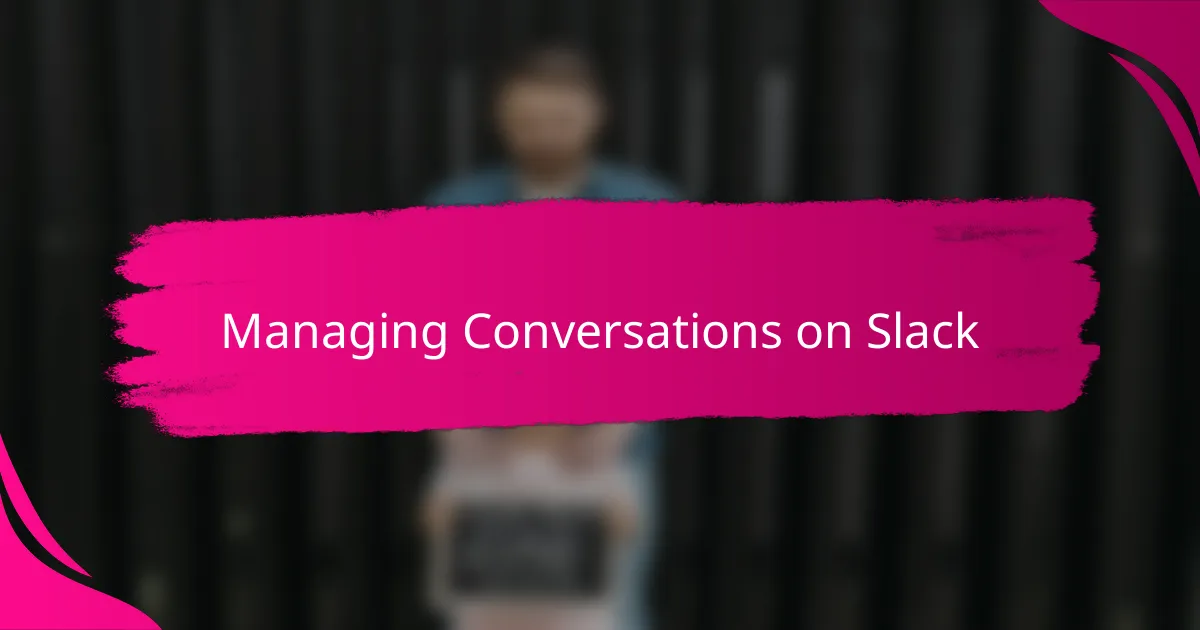
Managing Conversations on Slack
One thing I quickly learned about managing conversations on Slack is how threads can keep discussions organized. Instead of scrolling through a jumble of messages, using threads lets you follow specific topics without losing track. Have you ever felt overwhelmed trying to catch up on a long conversation? Threads changed that for me by making it easier to stay focused.
Another helpful feature is the ability to mute channels that aren’t relevant at the moment. I found this really useful during busy times when I only wanted to see urgent updates. It’s amazing how a little control over notifications keeps the noise down and helps you stay sane amid all the parenting chatter.
But here’s the catch: managing conversations only works well if everyone in the group follows some simple etiquette. Encouraging members to use clear subject lines in channels and to respond thoughtfully builds a respectful environment where real support can happen. Don’t you think that’s crucial when we all need to feel heard and valued?
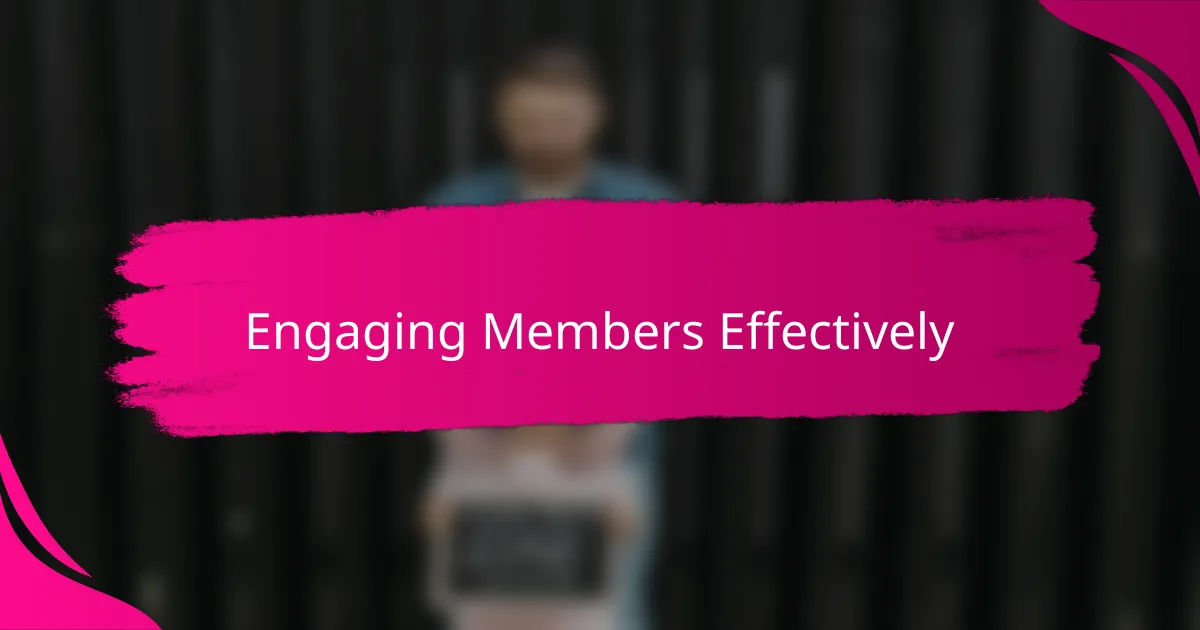
Engaging Members Effectively
Engaging members effectively on Slack requires more than just setting up channels—it’s about sparking genuine interaction. I found that when someone takes the time to ask open-ended questions or share personal stories, others are much more likely to join in. Have you noticed how a simple “How did your little one handle the first day of school?” can turn a quiet channel into a lively conversation? That personal touch makes all the difference.
I also noticed that timely responses are key. When I jump into a chat and see several replies already waiting, it motivates me to add my own thoughts. It’s like being part of a team working together in real time, which feels incredibly supportive during those late-night parenting dilemmas. Don’t you think having that immediate back-and-forth changes the whole dynamic compared to waiting days for emails?
Finally, it helps when group moderators gently encourage quieter members to share by tagging them or highlighting their expertise. I recall one time when a shy parent was invited to offer advice on sleep training, and suddenly their insights became a huge hit. It showed me that thoughtful engagement isn’t just about volume but about making everyone feel valued and heard. Have you experienced that sense of belonging in your group? That’s what I strive for with Slack.
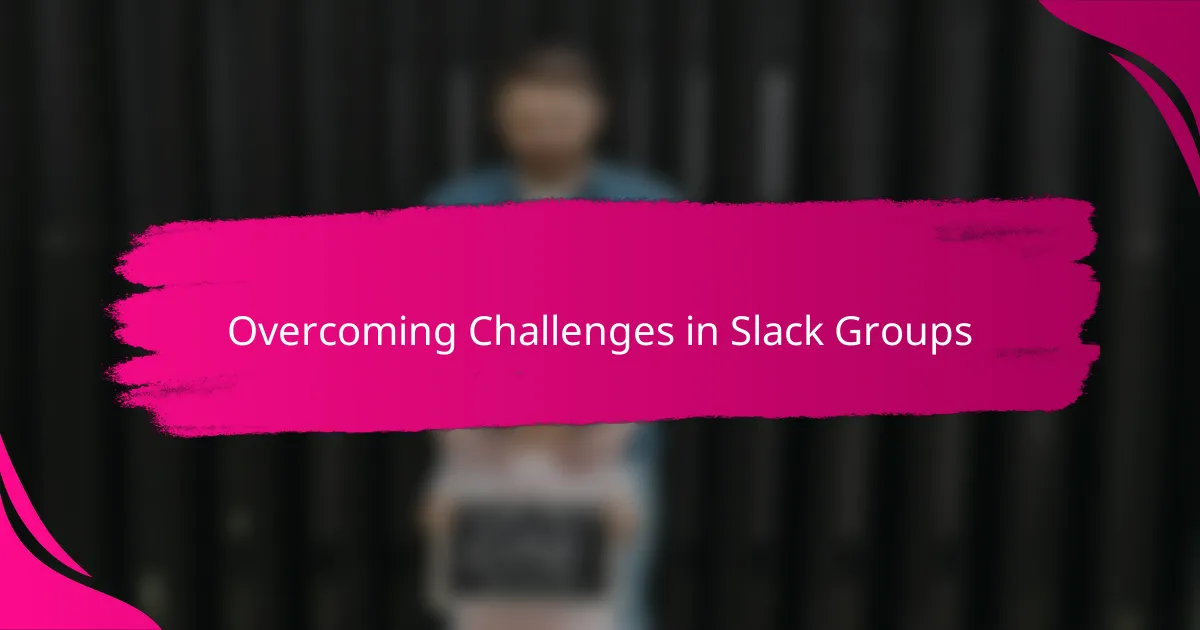
Overcoming Challenges in Slack Groups
Navigating the challenges in Slack groups can feel daunting at first, especially when the stream of messages starts to pile up. I remember feeling a bit overwhelmed by the constant notifications until I discovered the magic of muting less relevant channels and relying on threads to keep focused—have you tried that? It’s a small shift, but it really helped me regain control and reduced my digital overload.
Another hurdle I faced was getting everyone on the same page with etiquette. Without some gentle guidance, conversations can spiral into chaos or misunderstandings. I found that setting clear, simple group norms early on—like encouraging respectful replies and directing responses into threads—created a space where parents felt comfortable sharing openly. Doesn’t a respectful atmosphere make all the difference when you’re seeking support?
Then there’s the challenge of keeping energy alive in the group. Sometimes, participation dips, and the chat turns radio silent. I’ve learned that nudging quieter members with personal invitations or sharing relatable stories can reignite conversations. It feels rewarding when someone who usually stays silent suddenly opens up with helpful advice—don’t you love those moments of unexpected connection?
